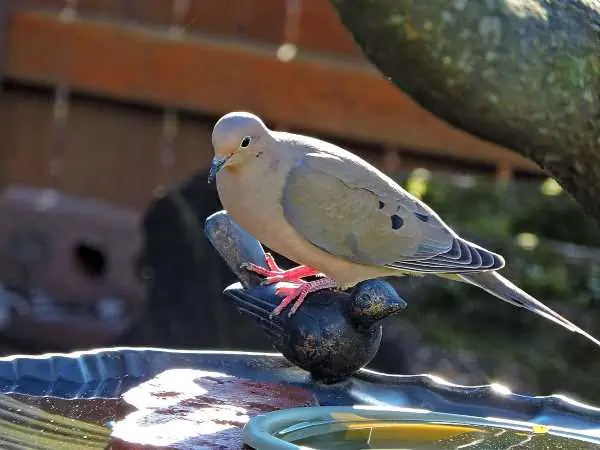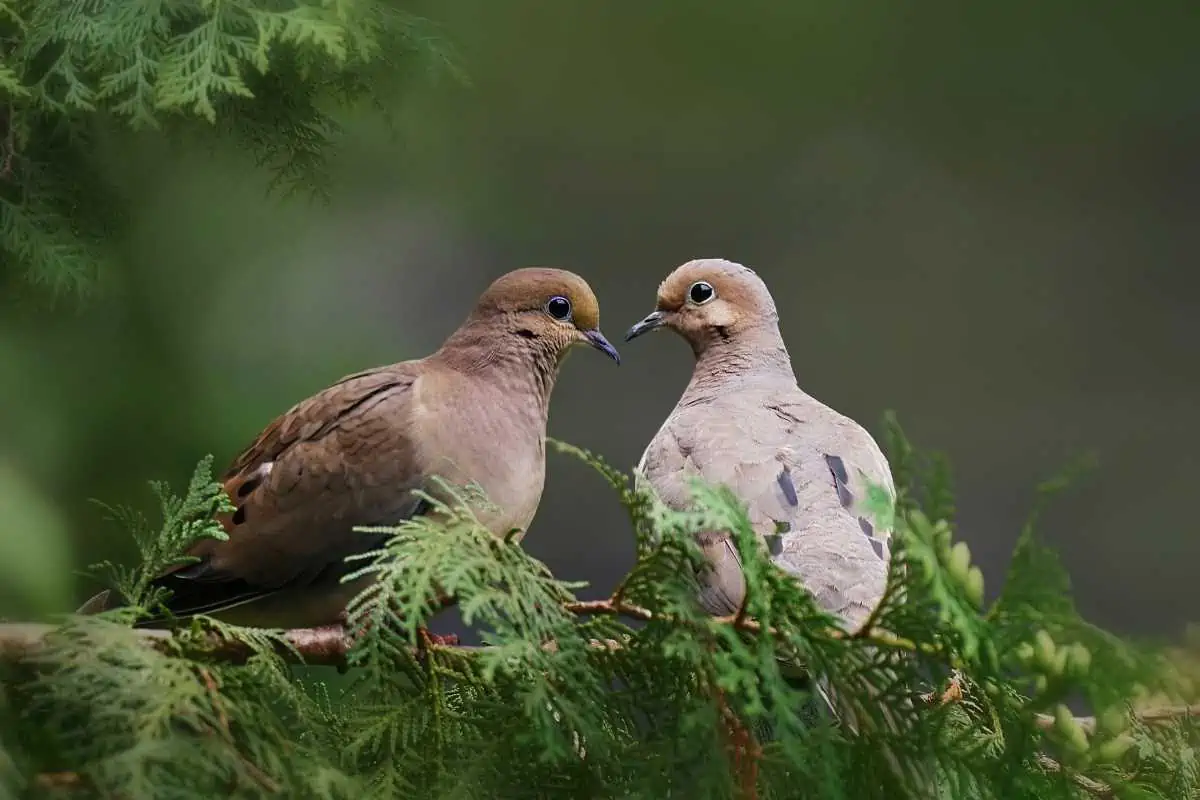Mourning doves are one of the most frequent species of birds found in America. They belong to the dove family and are members of the Dove Family. Their mournful cry is unmistakable. They’re also widespread in North America’s cities and suburbs. Let’s learn more about these peaceful birds by looking at some facts about mourning doves.
FACTS ABOUT MOURNING DOVES
1. THEY ARE FOUND THROUGHOUT NORTH AMERICA
Mourning Doves may be seen all year round in the United States. In the Caribbean and sections of Mexico, they are year-round residents. Throughout the summer, a population expands into lower Canada, while at winter, it spreads into Central America.
2. THEY ARE A POPULARLY HUNTED BIRD
One of the most often shot birds in the nation is the mourning dove. Out of a population of about 350 million people, around 20 million are harvested each year. Although they don’t appear to belong with game birds like grouse, quails, or pheasants, this may be surprising.
However, they are abundant, fascinating to hunt down, and delicious. Because Mourning Doves are protected under the Migratory Bird Treaty Act, special permits and licenses are necessary to hunt them. They are technically classified as a migratory bird.
3. MOURNING DOVES FAVORITE HABITAT MIRRORS THAT OF HUMANS
These birds prefer the same environment that we do, which is one of the reasons they are so widespread. They avoid densely wooded areas, instead preferring open and semi-open terrain. Parks, neighborhoods, farms, grasslands, and open woods are all examples of this. As a result, the following fact emerges
4. AMERICA’S MOST WIDESPREAD BREEDING BIRD
Mourning Doves may currently be found breeding in every state in the union, with the exception of Hawaii and Alaska. Few, if any, other bird species can make the same claim.
These birds were probably discovered in several locations of the land when the first European immigrants arrived from Europe, but they were not as common. The dove’s territory grew as forests were logged, allowing for agriculture and colonization.

5. THEY SPEND A LOT OF TIME ON THE GROUND
Mourning Doves spend a lot of time on the ground, despite their ability to fly and perch in trees. They can walk around, as can their relative the pigeon, and prefer to forage for seeds and other food on the ground. You’ll most likely observe them searching for seed among the feeders or employing a platform feeder if you have backyard bird feeders.
“They might be vulnerable to a variety of predators, especially house cats, if they spend a lot of time out in the open on the ground.” Mournful doves are prey on cats in large numbers.
6. MOURNING DOVES CONSUME A LOT OF SEEDS
In comparison to other birds of similar sizes, mourning doves can consume a large quantity of food. They will eat between 12 and 20% of their body weight every day. They eat seeds almost entirely, although berries and snails are occasionally eaten.
“Mourning doves have a portion of their esophagus known as a crop, which allows them to consume so much.” From a safe perch, the crop can hold a large number of seeds that the mourning dove will later digest. In fact, a Mourning Doves crop once yielded over 17,200 bluegrass seeds!
7. THEY CAN SURVIVE IN THE DESERT
Mourning doves, unlike many other species of birds, can live in the deserts of the United States. Southwest and Mexico are also options. Their capacity to drink brackish spring water is one adaptation that aids them with this. The mix between freshwater and ocean saltwater is called brackish water.
Most animals, including humans, cannot consume brackish water without becoming dehydrated. It has enough salt in it. Without becoming dehydrated, Mourning Doves can drink brackish water.

8. THEY CAN LIVE UP TO 30 YEARS
If they are not hunted or killed by predators, mourning doves can live to be pretty old. In the wild, they have a 2-7 year lifespan on average. Yet, he was shot by a hunter in Florida in 1998, and his age was approximately 30 years old. In the state of Georgia, he was banded in 1968.
9. MOURNING DOVES HAVE A FEW NICKNAMES
You may have heard different names for mourning doves before. The American Mourning Dove is their longest name, although they’re commonly referred to as “turtle doves.” Some call them “rain doves” as well. Carolina turtle doves and Carolina pigeons were the names given to these birds at one time. These birds aren’t actually turtle doves, despite their nicknames.
10. THEIR NAME COMES FROM THEIR CALL
People often assumed it sounded sad or mournful when they heard one of their cooing calls, hence the name “Mourning.” This is a term used to describe their mating call, which is a melody created from an open perch by unmated males. A tree limb or a roof may be used to do this in your yard. A coo-oo is followed by two or three distinct coos.

11. MALES AND FEMALES LOOK THE SAME
Mourning Doves have the same plumage as both sexes, unlike a species like the Northern Cardinal, where males and females are clearly discernible. The body is light gray, with peach-colored underparts, black wings, and pink legs.
Males have somewhat brighter heads and pinker breasts than females, who are a little bit bigger. Yet, there are slight differences that would require you to be quite close to discern them.
12. THEY NEST IN A VARIETY OF PLACES
Mourning Doves may breed in a number of settings, depending on where they are located. They often nest on the ground in the west, but prefer to nest in trees and shrubs in the east, for example. They may even nest in the crook of a cactus in the desert. They’ll frequently end up in gutters, eaves, and planters around the house because they aren’t bothered by nesting near humans.

13. MATING FOR LIFE
Mourning doves marry for life in the majority of cases. Unless something happens to one of them, once a man and a woman have teamed up, they tend to stick together.
The guy looks for prospective nest sites, while the lady makes the ultimate choice. He’ll bring the female some nesting supplies, such as pine needles and twigs, and she’ll use them to construct the nest. Nests are frequently lightweight and lack insulation or lining.
A single female mourning dove will lay just two eggs throughout her mating season, but she may do it again. Female mourning doves may lay up to 12 eggs before the conclusion of the season.
14. BOTH SEXES SHARE INCUBATION DUTY
Males and females compete for the opportunity to incubate the eggs. Females prefer the early morning, evening, and night shift, while males prefer the late morning to mid-afternoon shift, according to those who have closely monitored the nests.
15. THEY ENGAGE IN PAIR-BONDING RITUALS
As part of a bonding ritual, male-female pairs of Mourning Doves will preen each other’s neck feathers. Eventually, they’ll bob their heads up and down in time with one another as they grasp each other’s beaks.
16. THEIR WINGS MAKE A SOUND WHEN THEY TAKE OFF
Every time a Mourning Dove takes off from the ground, it makes a whistling or “whinny” noise, which you may have noticed if you’ve spent any time around them. Their wing feathers produce this sound, not their throats. The doves are said to be using it as a built-in alarm system, scaring nearby predators and informing nearby birds, according to theories.
